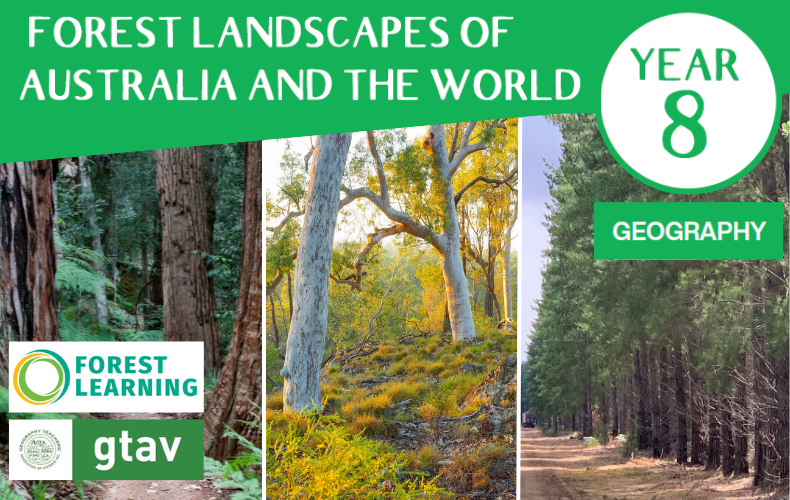Geography Year 8: Forest Landscapes of Australia and the World
Lesson Overview:
Forests are important to all species on Earth. Forests provide shelter, food and other resources, they clean our water and protect our soils, they are the guardians of the climate. Forests provide us with inspiration and enjoyment, and are also of economic importance. The different forest types around the world require careful management to ensure their needs and human needs are met in a balanced way.
This resource discusses how forest characteristics and distribution relate to the climate as climate change becomes a larger consideration for forest health and management. It also explores where wood products come from and the sustainable management of forest cycles for wood production.
What’s in the resource
- Student Workbook – two formats of pdf available:
- Printable version with lines, or
- Online digital interactive pdf version that could be used as a student assessment option.
- Teacher Workbook – complete with lesson outcomes and Australian Curriculum links, answers to all questions found within the Student Workbook, curriculum overview and mapping, Forest Glossary, lesson timings, suggested groupings for activites, extension activities, teacher tips, assessment options, references and all links.
- Embeds Ed Tech including ForestVR video experiences & online 360-degree ForestLearning VRTY photo tours complete with information and photo hotspots for further information on Australia’s forest types. All Ed Tech is available to view on any device or technology a school / student already owns including laptop, smart board, ipad or VR Headset.
- Multimedia-rich to bring forests to life!
Lesson Sequence
LESSONS 1-2 WHAT IS A FOREST
AIM: To explore what a forest is and understand how spatial patterns in latitude and climate affect forest landscapes and their distribution.
OUTCOMES: Students will:
• Examine the definition of ‘forest’ and why this is considered a landscape.
• Create a photo map of forests visited and investigate how forests differ worldwide.
• Analyse how spatial patterns such as latitude and climate affect forest landscapes.
LESSONS 3-5 EXPLORING FORESTS
AIM: To understand the structure, classification, and distribution of Australian forest landscapes with the use of geospatial technologies and describe the characteristics of forest landscapes from Australia and around the world.
OUTCOMES: Students will:
• Understand how forests are classified or labelled according to their structure.
• Analyse spatial data maps to recognise patterns in the natural distribution of forests in Australia and the interconnection between forests and climate.
• Explore different forest characteristics around the world.
• Use both digital and spatial technologies to gain an understanding of forest characteristics.
LESSONS 6-8 FORESTS FOR ALL FOREVER
AIM: To compare and contrast the features and values of natural (native) forests and manmade forests (commercial plantations), and to evaluate the sustainability of plantation forestry.
OUTCOMES Students will:
• Compare the characteristics, uses and values of natural and man-made forests.
• Explore the values of forests to First Nations Australians.
• Evaluate the effectiveness of sustainable plantation forestry.
• Utilise various visual thinking routines and practice writing an extended response.
Background to this Resource
ForestLearning and the Geography Teachers Association Victoria have developed this eight-lesson resource for Year 8 Geography sub-strand, Landforms and Landscapes. Students will investigate Australian forest characteristics, dynamics and how forest diversity and distribution are related to climate. Forest values, including cultural and spiritual values are examined, as well as how forest values can be sustainably managed.
As a part of this resource, students will ‘visit’ a number of different Australian forests through ForestLearning’s ForestVR virtual reality 360-degree videos and tours. Virtual fieldwork, although not a full replacement for actual fieldwork, can provide an exciting opportunity for immersive learning experiences that might otherwise be inaccessible. Place, environment, sustainability, interconnection and values are explored using spatial maps, data interpretation and critical thinking.
To reap maximum benefits, students will ideally have access to individual computers to work through these lessons. Smart board whole class demonstrations or small group access to a laptop or tablet device are also options.
ForestLearning’s ForestVR Toolkit for Schools can be found at forestlearning.edu.au/forestvr. ForestVR can be viewed using any device with a web browser or a virtual reality (VR) headset. If approved for use, smartphones can be made into headsets using ForestLearning’s DIY template, see below. A classroom-ready ForestVR App is available
to download for iOS, Android and Oculus Go devices, complete with Teacher Sync function. Learn more here: forestlearning.edu.au/forestvr
FURTHER VR TOOLS:
• Make your own (DIY) VR Headset
• ForestLearning short activity instructions + printable template – Create your own Virtual Reality Headset:
https://forestlearning.edu.au/find-a-resource/article/109/forestvr-short-activity-create-avirtual-reality-headset.html
• VR Safety poster to download and display for the classroom
Related Resources:
Forest Landscapes of the World - Photos
Forests are found all around the world but they are not all the same. Explore three forests from around the world - Tropcial rainforest: Borneo, Indonesia, Taiga (Boreal) forest: Alaska, North America, and the Temperate deciduous forest: Slovenia, Europe.
Forest Landscapes of the World – Photos Geography Year 8: Forest Landscapes of Australia and the WorldYear Level/s:
Key Curriculum Areas / Subject:
N/A
National Curriculum Codes:
Strand Content Description:
N/A
General Capabilities:
N/A
Cross Curriculum Priorities:
Curriculum Connections:
ScOT Catalogue Terms:
N/A
Theme/s:
Resource Type/s:
Primary:
LessonSecondary:
Workbook/Worksheet
student Resource
Forest Landscapes Yr8 Geography - Student Resource: DIGITAL version
Interactive Student PDF workbook for use on a laptop or PC.
File Size: 12.49 MB
File Type: pdf
Loginstudent Resource
Forest Landscapes Yr 8 Geography- Student Resource: PRINT version
Printable student PDF workbook - with lines for student written answers.
File Size: 12.41 MB
File Type: pdf
Loginteacher Resource
Teacher PDF Resource
This workbook follows the student workbook and contains suggested answers to all questions, assessment options, curriculum overview, lesson curriculum links, teacher tips, suggested timings, activity suggested student groupings, and references.
File Size: 11.21 MB
File Type: pdf
Login